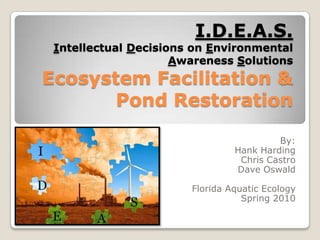
Ecosystem Facilitation
- 1. I.D.E.A.S.Intellectual Decisions on Environmental Awareness SolutionsEcosystem Facilitation & Pond Restoration By: Hank Harding Chris Castro Dave Oswald Florida Aquatic Ecology Spring 2010
- 2. The Problem: The current chemical maintenance methods of spraying ‘heavy metals’ for short-term elimination of algae cause by cultural eutrophication.
- 5. Chemically maintaining plants or algae, containing hazardous metals that could potentially enter our aquifer.These techniques are costly, both economically and ecologically!
- 7. Changes to invertebrate cellular and cuticle structure——interferes with fitness, life history timing, ability to feed, obtain oxygen, or reproduce
- 9. The Result? The lake ecosystem shifts from macrophytic plants to microscopic plants (algae and blue blue-green algae) Thus begins the cycle of unwanted algal blooms aka Cultural Eutrophication.
- 11. This process slows the velocity of surging water into a retention pond and allows natural filters to absorb algae-producing-nutrients.This is.. I.D.E.A.S. Ecosystem Facilitation!
- 12. Torpedo Grass Water Milfoil Aquatic InvasivesStep 1: Environmentally friendly removal
- 13. Torpedo Grassecosystem invasive aquatic removal
- 14. Aquatic Plant ContinuumStep 2: Plant Native Aquatics
- 15. Emergent Native Aquatics Softrush (Juncuseffusus) Horsetail (Equisitum sp.) Stabilize the banks of water sources, preventing soil erosion and topsoil loss. Horsetail can act as an insecticide when used in strong concentrations. Used with nettle, its potential increases, including its use to eliminate fungi Provide habitats for many micro and macro invertebrates. These invertebrates in turn are used as food by fish and other wildlife species (e.g. amphibians, reptiles, ducks, etc.). After aquatic plants die, their decomposition by bacteria and fungi provides food (called "detritus") for many aquatic invertebrates. Waterfowl, game birds, and song birds will consume seeds of soft rush (and other rushes).
- 18. Provides cover for water fowl, insects, small mammals
- 19. Have root tubers which are eaten by native waterfowl During the growing season notable amounts of nutrients and metals are extracted by Sagittarialatifolia from sediments and water.
- 21. Inflorescence flower- provides nectar to bees and butterflies , also attrats dragonflies.
- 23. Potential for removing excess nutrients
- 26. Habitat for waterfowl
- 27. Native plant richness
- 28. Shoreline stabilizationBenefits of Natural Shoreline Ecosystem Continued…
- 32. Retention Pond DataFall 2009
- 35. Aztec methods of growing crops without land. Created floating islands over open water as a source to cultivate food and crops. We are experimenting with them as a “filtration system” for retention ponds. Supplies: Bamboo, Hemp rope, Pine Needles, Soil Medium, Aquatic plants Chinampas: History and Use
- 36. Algae acts as a natural filter to nutrients from runoff water, as well as chemicals. Our methods involve manually removing the algae and applying it to terrestrial plants and buffer zones for additional nutrients Why Algae?Step 4: Re-use as Terrestrial Fertilizer
- 38. The breakdown of Ecosystem Facilitation.. When: est.January 2009. Where: The Crest Why: To relieve the issue of algal blooms, without the use of harmful chemicals How: creating a sustainable system of natural riparian buffers
- 39. The Crest: Pond 1 & 10February 20, 2010
- 43. Lake I.D.E.A.S. RestorationMarch 20, 2010
- 44. -$400 was donated by Sterling Central Apts. & UCF Landscape & Natural Resources. -Over 130 plants we’re purchased and planted in the lake. -Created 3 riparian buffer ecosystems around Lake I.D.E.A.S.
- 46. Lake I.D.E.A.S. Restoration pt.2April 8, 2010
- 47. -focused on mechanical maintenance and removal of aquatic invasives. Why? - Opened up the availability from native aquatics to thrive easier, without over competing.
- 48. ..2 weeks later
- 49. ..So what’s next for Lake I.D.E.A.S.?
- 50. For helping I.D.E.A.S. Ecosystem Facilitation!